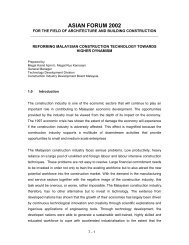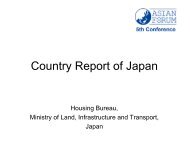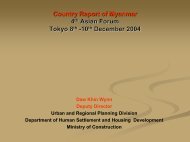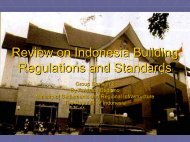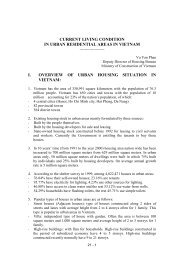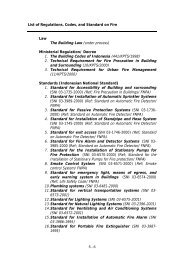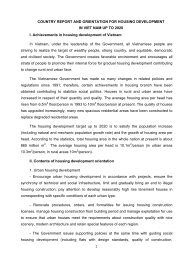Sustainable Building Design and Construction in Nepal with ...
Sustainable Building Design and Construction in Nepal with ...
Sustainable Building Design and Construction in Nepal with ...
Create successful ePaper yourself
Turn your PDF publications into a flip-book with our unique Google optimized e-Paper software.
<strong>Susta<strong>in</strong>able</strong> <strong>Build<strong>in</strong>g</strong> <strong>Design</strong> <strong>and</strong> <strong>Construction</strong> <strong>in</strong> <strong>Nepal</strong><br />
<strong>with</strong> reference to Urban Hous<strong>in</strong>g: Issues <strong>and</strong> Proposed<br />
Measures.<br />
- Manohar Rajbh<strong>and</strong>ari, <strong>Nepal</strong><br />
1. Introduction<br />
Out of three basic needs of human be<strong>in</strong>g, i.e., food, cloth<strong>in</strong>g <strong>and</strong> shelter; the toughest <strong>and</strong> most<br />
difficult to meet is shelter. Rapid urbanization of Kathm<strong>and</strong>u <strong>and</strong> other major urban centers has<br />
resulted <strong>in</strong> haphazard urban growth <strong>with</strong> subsequent concentration of population <strong>and</strong> their<br />
socio- economic activities <strong>with</strong><strong>in</strong> the urban area. This has resulted <strong>in</strong> spiral<strong>in</strong>g cost of l<strong>and</strong>,<br />
build<strong>in</strong>g material <strong>and</strong> labour. This paper tries to highlight the major issues <strong>and</strong> proposed<br />
measures for design <strong>and</strong> construction of earthquake resistant <strong>and</strong> affordable urban hous<strong>in</strong>g <strong>in</strong><br />
<strong>Nepal</strong>.<br />
2. Contextual Background<br />
A survey carried <strong>in</strong> the year 1990 <strong>in</strong>dicated that there were altogether 3 million houses <strong>in</strong> <strong>Nepal</strong> of<br />
which 90 percent were <strong>in</strong> the rural area <strong>and</strong> only 300,000 <strong>in</strong> urban areas. The survey also <strong>in</strong>dicates that<br />
the total number of dwell<strong>in</strong>g units required for the period of 2002 to 2006 is 174,900. Hence the<br />
dem<strong>and</strong> for houses is 34,980 per year. This is due to rapid urbanization, especially <strong>in</strong> Kathm<strong>and</strong>u, due<br />
to job opportunities <strong>in</strong> the capital city <strong>and</strong> recently, sadly, due to political <strong>in</strong>surgency <strong>in</strong> rural areas.<br />
Urban areas are undergo<strong>in</strong>g considerable growth <strong>with</strong>out concomitant growth <strong>in</strong> employment,<br />
<strong>in</strong>frastructure <strong>and</strong> basic services. As per National Census 2001, the growth rate of urban <strong>and</strong> national<br />
population is recorded at 3.56 % <strong>and</strong> 2.27 % respectively, <strong>with</strong> total urban population recorded at 3.25<br />
million ( 14 % of national population of 23.15 million). Its urban growth rate of 5.89 % <strong>and</strong><br />
urbanization rate of 3.79 % (1991 census) was the highest amongst SAARC countries.<br />
To fulfill the dem<strong>and</strong> for hous<strong>in</strong>g, government, f<strong>in</strong>ancial <strong>in</strong>stitution <strong>and</strong> private sector have lately<br />
started organized hous<strong>in</strong>g <strong>and</strong> related activities.<br />
The government sector has started number of L<strong>and</strong> Pool<strong>in</strong>g or L<strong>and</strong> Adjustment Projects. More that 11<br />
L<strong>and</strong> Pool<strong>in</strong>g Projects cover<strong>in</strong>g 242 hectares of l<strong>and</strong> have been implemented successfully.<br />
Dur<strong>in</strong>g last five years numbers of private hous<strong>in</strong>g developers have stepped <strong>in</strong>to this market. There are<br />
more than 42 numbers of hous<strong>in</strong>g companies registered <strong>with</strong> the government <strong>and</strong> by next year, 600 to<br />
800 units will be ready. They are provid<strong>in</strong>g the buyers <strong>with</strong> a variety of hous<strong>in</strong>g schemes <strong>and</strong> locations<br />
<strong>in</strong> Kathm<strong>and</strong>u, Pokhara, Lumb<strong>in</strong>i <strong>and</strong> Dharan. The phenomenal success of the hous<strong>in</strong>g companies has<br />
Page 1 of 4
proven that there is tremendous potential for hous<strong>in</strong>g <strong>in</strong>dustries <strong>in</strong> <strong>Nepal</strong>. Some of the hous<strong>in</strong>g<br />
companies are jo<strong>in</strong>t ventures between companies from neighbour<strong>in</strong>g country <strong>and</strong> those of <strong>Nepal</strong>. Also,<br />
some of the designs have been done by foreign architects.<br />
3. Major Issues<br />
3.1 Status of <strong>Build<strong>in</strong>g</strong> Structures<br />
Most of the structures done by hous<strong>in</strong>g developers are <strong>with</strong> RCC frame <strong>and</strong> all of them claim that they<br />
have designed earthquake resistant structures. Recently government has made it m<strong>and</strong>atory to adopt<br />
The <strong>Nepal</strong> <strong>Build<strong>in</strong>g</strong> Code for all new constructions. The <strong>Nepal</strong> <strong>Build<strong>in</strong>g</strong> Code covers all aspects of<br />
build<strong>in</strong>gs. It has 23 volumes for <strong>Design</strong> requirements, Material Specifications, Guidel<strong>in</strong>es, Architectural,<br />
Electrical <strong>and</strong> Sanitary requirements <strong>and</strong> Safety requirements. This has <strong>in</strong>itiated new problem, what<br />
about the build<strong>in</strong>gs built before implementation of this <strong>Build<strong>in</strong>g</strong> Code In my op<strong>in</strong>ion, only option now<br />
left for the owners of those build<strong>in</strong>gs is to get assessment of their build<strong>in</strong>gs for structural safety from<br />
qualified structural eng<strong>in</strong>eers. If the assessment reveals that a particular build<strong>in</strong>g is not safe, then the<br />
owner of that build<strong>in</strong>g should adopt strengthen<strong>in</strong>g by retrofitt<strong>in</strong>g of the structure. Strengthen<strong>in</strong>g by<br />
retrofitt<strong>in</strong>g of exist<strong>in</strong>g structure is a new topic, which is not well known even by most of the practic<strong>in</strong>g<br />
eng<strong>in</strong>eers, forget about the common public. May this forum members can lend help<strong>in</strong>g h<strong>and</strong>s <strong>in</strong> tra<strong>in</strong><strong>in</strong>g<br />
this new subject to <strong>Nepal</strong>ese Eng<strong>in</strong>eers.<br />
Recently the Kathm<strong>and</strong>u Metropolitan City <strong>and</strong> Lalitpur Sub-Metropolitan City have made it<br />
compulsory to submit detail structural designs of build<strong>in</strong>gs for gett<strong>in</strong>g permission for their construction.<br />
Moreover, municipal eng<strong>in</strong>eers have started check<strong>in</strong>g the structural designs <strong>and</strong> mak<strong>in</strong>g necessary<br />
rectifications, if found faulty. This could be considered as a positive step <strong>in</strong> the field of construction of<br />
safe structures.<br />
3.2 Public Perceptions on Safety of <strong>Build<strong>in</strong>g</strong>s<br />
Due to massive publicity by news media about effect of recent tsunami <strong>and</strong> earthquake <strong>in</strong> Asia Pacific<br />
Region, many <strong>in</strong>dividual house builders have shown their concerns regard<strong>in</strong>g the safety of build<strong>in</strong>gs,<br />
especially <strong>in</strong> case next big earthquake occurs. This <strong>in</strong>creased awareness, <strong>in</strong> itself, is a good sign.<br />
However, lot more is desired <strong>in</strong> mak<strong>in</strong>g public aware of the affect of earthquake <strong>and</strong> of a need of<br />
construct<strong>in</strong>g earthquake resistant build<strong>in</strong>gs.<br />
Recent seismic activity <strong>in</strong> Himalayan belt shows that there is a slip deficit- a non-recurrence of<br />
earthquakes to release the stress that is accumulat<strong>in</strong>g. The most notable area of concern is the central<br />
Himalayan Gap, a 600 km. long central area of the Himalayas. This area has the potential to generate<br />
several earthquakes of magnitude 8 or more. The 600 km. long Himalayan Gap lies <strong>in</strong> <strong>Nepal</strong>. A survey<br />
carried out by a Japanese team shows that 400,000 people will die <strong>and</strong> 95,000 will get wounded <strong>in</strong><br />
Kathm<strong>and</strong>u Valley, <strong>in</strong> the event of such an earthquake. Hence, it is imperative that the design <strong>and</strong><br />
Page 2 of 4
construction of hous<strong>in</strong>g must be done, keep<strong>in</strong>g earthquake safety <strong>in</strong>to consideration. More efforts on the<br />
part of concerned government <strong>and</strong> local authorities is needed to make people aware of the gravity of<br />
situation.<br />
3.3 Urban Poverty <strong>and</strong> Implications on Hous<strong>in</strong>g.<br />
Accord<strong>in</strong>g to <strong>Nepal</strong> Liv<strong>in</strong>g St<strong>and</strong>ards Survey (NLSS)/ World Bank (1996), 23 % urban households fall<br />
below poverty l<strong>in</strong>e, compared to 44 % rural households <strong>and</strong> 42 % <strong>Nepal</strong>ese as a whole. Due to poverty,<br />
people can not consult structural eng<strong>in</strong>eers for design of earthquake resistant structures. They construct<br />
their houses <strong>with</strong> the help of local labour contractors, who themselves do not know about construction<br />
of safe structures. Moreover, due to low budget, they are forced to use low quality construction<br />
materials, result<strong>in</strong>g <strong>in</strong> construction of weak structures.<br />
Also, use of Low Cost <strong>Construction</strong> Technology can be helpful to meet the dem<strong>and</strong> of hous<strong>in</strong>g for poor<br />
people. Some NGOs, like SLTD, Lumanti are active <strong>in</strong> this field. SLTD is promot<strong>in</strong>g the use of precast<br />
light weight slabs, concrete blocks for the construction of low cost <strong>and</strong> earthquake resistant structures. I<br />
th<strong>in</strong>k this Forum can come forward <strong>in</strong> promot<strong>in</strong>g use of such technology, which will go a long way <strong>in</strong><br />
help<strong>in</strong>g the group <strong>in</strong> society who can not afford for decent build<strong>in</strong>g construction.<br />
3.4 Limitations faced by Private Hous<strong>in</strong>g Companies<br />
The biggest problem for the hous<strong>in</strong>g companies is to f<strong>in</strong>d sizeable area <strong>with</strong><strong>in</strong> urban area <strong>and</strong> lack of<br />
proper legislation. Hence it will be very fruitful if the hous<strong>in</strong>g project <strong>and</strong> l<strong>and</strong> pool<strong>in</strong>g (adjustment)<br />
project go <strong>in</strong> t<strong>and</strong>em. This will also serve <strong>in</strong> sort<strong>in</strong>g out the present regulation of requirement of 7 m<br />
wide approach road for hous<strong>in</strong>g project.<br />
3.5 Poor Technical Skills of <strong>Construction</strong> Labor Force<br />
Most of the labour force <strong>in</strong>volved <strong>in</strong> construction is from farm<strong>in</strong>g community, <strong>with</strong>out any<br />
tra<strong>in</strong><strong>in</strong>g <strong>in</strong> basic construction trade. It will be very beneficial to them, if some sort of tra<strong>in</strong><strong>in</strong>g<br />
regard<strong>in</strong>g construction technique is provided to them. There are number of schools <strong>in</strong> <strong>Nepal</strong>,<br />
which could take up <strong>in</strong>itiations <strong>in</strong> this direction.<br />
3.6 Institutional Issues (Government Institutions, Professional Bodies, Educational<br />
Institutions, Contractors Associations)<br />
Lack of co-ord<strong>in</strong>ation <strong>and</strong> concerted approach amongst various organizations <strong>in</strong> the field of<br />
plann<strong>in</strong>g <strong>and</strong> construction technology is apparent <strong>in</strong> <strong>Nepal</strong>. For example, lack of proper<br />
regulatory framework along <strong>with</strong> a long <strong>and</strong> tedious l<strong>and</strong> acquisition process contributes to<br />
additional costs <strong>and</strong> time delays dur<strong>in</strong>g project formulation. It is necessary to formulate a<br />
Page 3 of 4
detailed plann<strong>in</strong>g <strong>and</strong> design guidel<strong>in</strong>es for hous<strong>in</strong>g projects. Most countries have accepted<br />
design st<strong>and</strong>ards <strong>and</strong> it would not be difficult to create one that is compatible to the <strong>Nepal</strong>ese<br />
context- probably by bas<strong>in</strong>g it on those of the neighbour<strong>in</strong>g SAARC countries.<br />
However, these guidel<strong>in</strong>es need to be realistic <strong>and</strong> while cater<strong>in</strong>g to public health <strong>and</strong> safety,<br />
they should also attempt to underst<strong>and</strong> the economic impact on the market <strong>and</strong> ma<strong>in</strong>ta<strong>in</strong> project<br />
validity. Failure to do so immediately would mean that the quality of hous<strong>in</strong>g developments<br />
would not be regulated <strong>and</strong> could lead to subst<strong>and</strong>ard products whose only sell<strong>in</strong>g po<strong>in</strong>t would<br />
be the price advantage. It could also adversely impact the entire planned hous<strong>in</strong>g <strong>in</strong>dustry<br />
<strong>in</strong>clud<strong>in</strong>g those that work towards ma<strong>in</strong>ta<strong>in</strong><strong>in</strong>g a certa<strong>in</strong> st<strong>and</strong>ard for development.<br />
4. Proposed <strong>Design</strong> Options related to <strong>Construction</strong> Materials <strong>and</strong> Technology.<br />
For safe <strong>and</strong> affordable hous<strong>in</strong>g, less material <strong>and</strong> hence, less dead load <strong>and</strong> appropriate<br />
technology, should be the criteria. Pre-cast slabs, pre-stressed hollow core slabs for horizontal<br />
structural members <strong>and</strong> high strength R.C. columns <strong>and</strong> wall elements of light weight concrete<br />
blocks for vertical members, <strong>with</strong>out loos<strong>in</strong>g aesthetics of the build<strong>in</strong>g <strong>and</strong> of simple<br />
configuration may be the answer.<br />
References:<br />
1. National Shelter Policy 1996, HMG , M<strong>in</strong>istry of Hous<strong>in</strong>g <strong>and</strong> Physical Plann<strong>in</strong>g,<br />
<strong>Nepal</strong><br />
2. Hous<strong>in</strong>g for Urban Poor <strong>in</strong> <strong>Nepal</strong> : Issues, Challenges <strong>and</strong> Vision for the Future,<br />
written by Mr. Umesh B. Malla, published <strong>in</strong> Shahari Bikas, 2005<br />
3. Cost Effective <strong>Build<strong>in</strong>g</strong> Materials <strong>and</strong> <strong>Construction</strong> Technology for Low Cost Hous<strong>in</strong>g<br />
<strong>in</strong> <strong>Nepal</strong>, written by Mr. B.L. Shrestha, presented <strong>in</strong> National Sem<strong>in</strong>ar on Science <strong>and</strong><br />
Technology held from March 8-11, 1999.<br />
4. The <strong>Nepal</strong> <strong>Build<strong>in</strong>g</strong> Code.<br />
5. Country Report on “ Hous<strong>in</strong>g Market ( Real Estate Bus<strong>in</strong>ess) <strong>in</strong> Kathm<strong>and</strong>u <strong>and</strong><br />
towards Develop<strong>in</strong>g a <strong>Susta<strong>in</strong>able</strong> <strong>Build<strong>in</strong>g</strong> Plann<strong>in</strong>g <strong>in</strong> <strong>Nepal</strong>”, submitted by Mr.<br />
Shashi Bahadur Thapa to Asian Forum on 12 January, 2004.<br />
6. Article published <strong>in</strong> a newspaper “Economist.”<br />
Page 4 of 4




